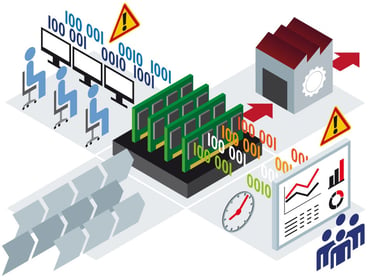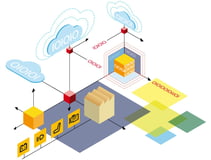5 Ways In-Memory Technology Adds Business Value
Brian Hoey - August 09, 2018

 Let’s say you and a coworker are attempting to find areas of waste in your supply chain. You have a large conference table on which you’ve laid a file that contains all of the transport plans utilized by the company for the past few years. When your coworker hypothesizes that a different grouping of goods would improve fuel efficiency, you need new documents with additional information, meaning that you have to leave the conference room and descend to the basement level where the files are kept. By the time you’ve returned, a new idea has occurred to your coworker, and you have to make a new trip to wherever your files are stored in order to retrieve the necessary information. The result of all this walking to and from the files? Some good cardio, but no plan to speak of.
Let’s say you and a coworker are attempting to find areas of waste in your supply chain. You have a large conference table on which you’ve laid a file that contains all of the transport plans utilized by the company for the past few years. When your coworker hypothesizes that a different grouping of goods would improve fuel efficiency, you need new documents with additional information, meaning that you have to leave the conference room and descend to the basement level where the files are kept. By the time you’ve returned, a new idea has occurred to your coworker, and you have to make a new trip to wherever your files are stored in order to retrieve the necessary information. The result of all this walking to and from the files? Some good cardio, but no plan to speak of.
Now, imagine that instead of traipsing around the office trying to retrieve information only as it became necessary, you kept all of the files that might be pertinent to your project on the conference table where you were working. All of a sudden, facts could be gathered and decisions reached within minutes. A more collaborative atmosphere would begin to develop under the improved conditions, and the entire planning process would become more streamlined and adaptable. With all relevant supply chain data not just available but already at your fingertips, new efficiencies and new ways to add value would begin to emerge.
While the superiority of the second scenario above may seem intuitive when it comes to physical files, many businesses fail to make the same connections when it comes to their databases and computer processing. To wit, companies throughout the global value stream have been slow to adopt in-memory technology—in part because, though the parallels to the circumstances above should be fairly clear, they’re not entirely sure what the relevant value propositions are. In pursuit of clarifying those value propositions, here are five ways that in-memory technology can help your business.
1. Decreased Latency
This is the most obvious parallel between in-memory technology (which stores information in such a way as to make it immediately accessible to whatever processes might need to use it) and the example of the physical files given above, but it’s also the foundation of all other sources of value. Many businesses don’t think of latency times as a mission-critical hurdle to overcome, but slow retrieval speeds can have a cascade effect that causes slowdowns in all planning workflows and makes certain processes virtually impossible. By removing those hurdles and slowdowns, organizations can pave the way for real-time supply chain information, which itself forms the cornerstone of many of the crucial value-drivers to follow.
2. Instantaneous Collaboration
Collaboration was an important element of the scenario sketched out above precisely because digital environments are constantly adapting to make collaborative endeavors smoother and more effective. Not only does in-memory computing drive real-time access to information, it can also enable users to run simulations that can be tweaked and reevaluated instantly with different parameters. Users can then share those simulations in real-time in order to more effectively communicate planning and operational possibilities throughout an organization. While this may not seem monumental, it can be likened to the difference between e-mail and Slack: on the one hand, a medium suited to asynchronous communication; on the other, a platform that encourages quick, on-the-fly communication in a highly social, digital environment.
3. Powering S&OE
At this point you may be noticing a theme: that the integration of real-time information can have significant ramifications across the entire value chain. In many ways, the apex of real-time’s transformative process is the introduction of sales & operations execution (S&OE) workflows into supply chain planning. S&OE, for the uninitiated, involves tracking real-time, up-to-the-minute changes in demand and transport conditions in order to keep longer term operational plans on track. By making small adjustments to daily and weekly supply chain operations (like inventory levels and transport logistics), S&OE can maintain the integrity of monthly or quarterly plans, thereby preserving value that might otherwise be lost in the case of either a delayed response to changing conditions or an overreaction to small disruptions.
4. Industry 4.0 Integration
While the first three value drivers on this list have primarily involved creating business value by smoothing out potential inefficiencies in existing workflows and value streams, in-memory technology can also help power more proactive changes, creating an infrastructure that will serve the supply chain of the future just as effectively as it meets present needs. For example, in-memory databases, by creating an environment that supports quick calculations, can help to speed up Industry 4.0 advances like autonomous machine decision making in production processes. As your factory or production floor moves towards a connected environment equipped for machine-to-machine communication, in-memory will ensure that your value chain’s new degree of connectivity leads to new agility and adaptability at the same time.
5. Advanced Analytics Adoption
Last but not least on the topic of future proofing the supply stream: advanced predictive and prescriptive analytics. We’ve already mentioned (albeit briefly) the importance of in-memory databases for running simulations, but once you’ve incorporated Industry 4.0 principles into your operations it’s possible to ascend to a whole new level of sophistication. By giving advanced analytics algorithms access to data with reduced latency, or even in real-time, your organization can improve the quality of its demand forecasts and uncover potential process improvements, thereby reducing disruptions and saving time and money.
LATEST POSTS
- Understand Circular Economy in The Manufacturing Industry
- How Can Industry 4.0 IT Integration Be Achieved Smoothly?
- The Significance of Order Sequencing in Discrete Manufacturing
- How to improve your Supply Chain Management: The Power of Control Towers
- Optimizing Human Resource Scheduling in Manufacturing: A Technological Approach



